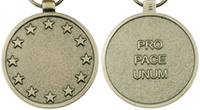
The Italian Armed Forces encompass the Italian Army, the Italian Navy and the Italian Air Force. A fourth branch of the armed forces, known as the Carabinieri, take on the role as the nation's military police and are also involved in missions and operations abroad as a combat force. Despite not being a branch of the armed forces, the Guardia di Finanza has military status and is organized along military lines. These five forces comprise a total of 340,885 men and women with the official status of active military personnel, of which 167,057 are in the Army, Navy and Air Force. The President of the Italian Republic heads the armed forces as the President of the High Council of Defence established by article 87 of the Constitution of Italy. According to article 78, the Parliament has the authority to declare a state of war and vest the powers to lead the war in the Government.
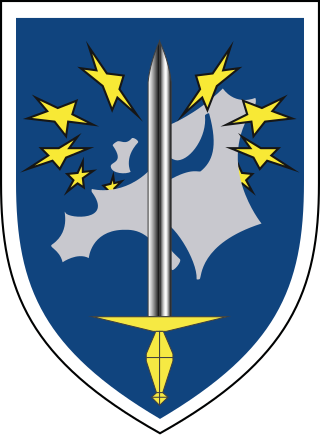
Eurocorps, located in the French city of Strasbourg (Bas-Rhin), is a multinational corps headquarters. Founded by France and Germany in 1992, it is today composed of personnel from six framework nations and five associated nations. The framework nations place the Eurocorps at the service of the European Union (EU) and NATO, which certified it in 2002 as one of its nine High Readiness Land Headquarters.

The European Gendarmerie Force (EUROGENDFOR) is a European rapid reaction force composed of elements of several European police and gendarmerie forces. EUROGENDFOR is tasked with performing policing tasks within the scope of crisis management operations.

The Common Security and Defence Policy (CSDP) is the European Union's (EU) course of action in the fields of defence and crisis management, and a main component of the EU's Common Foreign and Security Policy (CFSP).

Operation Althea, formally the European Union Force Bosnia and Herzegovina (EUFOR), is a military deployment in Bosnia and Herzegovina to oversee the military implementation of the Dayton Agreement. It is the successor to NATO's SFOR and IFOR. The transition from SFOR to EUFOR was largely a change of name and commanders: 80% of the troops remained in place. It replaced SFOR on 2 December 2004.
An international decoration is a military award which is not bestowed by a particular country, but rather by an international organization such as the United Nations or NATO. Such awards are normally issued as service medals, for participation in various international military operations, and not for specific acts of heroism or bravery.

The Military Staff of the European Union (EUMS) is the directorate-general of the European Union's (EU) External Action Service (EEAS) that contributes to the EU's Common Security and Defence Policy (CSDP) by providing strategic advice to the High Representative (HR/VP) and commanding operations through its Military Planning and Conduct Capability (MPCC) operational headquarters. From the end of 2020, the MPCC will be capable of running executive operations of up to 2,500 troops, i.e. the size of one EU battle group, as well as 3 non-executive missions.

European Union Force Chad and the Central African Republic, also EUFOR Tchad/RCA after the French, was the European Union mission in Chad and the Central African Republic (CAR), authorised in late 2007. EUFOR Chad/CAR was authorised under the same United Nations Security Council resolution that mandated MINURCAT, a UN force tasked with training police and improving judicial infrastructure.

The European Union Rule of Law Mission in Kosovo, known as EULEX Kosovo or simply as EULEX, is the largest civilian mission ever launched under the Common Security and Defence Policy (CSDP) of the European Union. EULEX supports selected Kosovo rule of law institutions on their path towards increased effectiveness, sustainability, multi-ethnicity and accountability, free from political interference and in full compliance with international human rights standards and best European practices.
An international decoration is a military award which is not bestowed by a particular country, but rather by an international organization such as the United Nations or NATO. Such awards are normally issued as service medals, for participation in various international military operations, and not for specific acts of heroism or bravery. The first medal from an international organization accepted for wear by the United States Military was the United Nations Korea Medal in 1951. Subsequent acceptance of other United Nations Medals did not come until 1964 with Executive Order 11139. Acceptance of the medals of other international multilateral organizations finally came with Executive Order 11446 in 1969. Acceptance of these international decorations must be approved by not only the Secretary of Defense, but also the Secretary of State.
EUFOR Concordia was a European Union (EU) peacekeeping mission in the Republic of North Macedonia, which started on 31 March 2003. The EU took over from NATO's operation Allied Harmony and deployed around 300 troops to provide security to EU and Organization for Security and Co-operation in Europe (OSCE) monitors overseeing the implementation of the Ohrid Framework Agreement, a peace settlement resolving the conflict between the government and country's ethnic Albanian community. It thus became the first ever military operation of the EU. While keeping EU's control over the entire chain of command the mission closely cooperated with NATO through transparency and regular consultations and its headquarters were at the Supreme Headquarters Allied Powers Europe in Mons. France suggested fully autonomous EU operation but United Kingdom and Germany feared it will be perceived as antagonistic to NATO.

European Union Force RCA, commonly referred as EUFOR RCA, is the United Nations-mandated European Union peacekeeping mission in Bangui, capital of the Central African Republic. The goal of the mission is to stabilize the area after more than a year of internal conflict. Agreement about the mission was reached in January 2014, and the first operations started at the end of April. The mission ended its mandate after nearly a year on 15 March 2015.
Lars-Gunnar Bertil Wigemark is a Swedish diplomat.

This article outlines the defence forces of the European Union (EU), which implement the EU's Common Security and Defence Policy (CSDP) in CSDP missions. There are two categories of EU multinational forces: ones that have been established intergovernmentally and made available to the CSDP through article 42.3 of the Treaty on European Union (TEU), such as the Eurocorps; and the EU Battlegroups, established at the EU level.
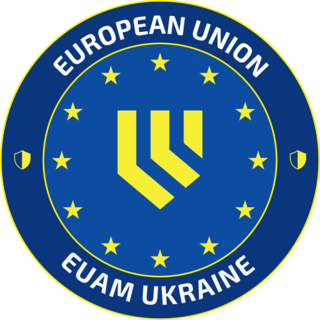
European Union Advisory Mission Ukraine is a civilian Common Security & Defence Policy (CSDP) mission of the European Union. It aims to assist Ukrainian authorities to reform civilian security sector. It provides strategic advice and practical support to make Ukrainian civilian security sector more effective, efficient, transparent and enjoying public trust. EUAM Ukraine works with a number of law enforcement and rule of law institutions of Ukraine, and it formally began operation on 1 December 2014, following Ukrainian Government's request.

This article outlines the present structure of the European Union's Common Security and Defence Policy (CSDP), a part of the Common Foreign and Security Policy (CFSP) based on articles 42–46 of the Treaty on European Union (TEU). Article 42.2 of TEU states that the CSDP includes the 'progressive framing' of a common Union defence policy, and will lead to a common defence, when the European Council of national heads of state or government, acting unanimously, so decides.
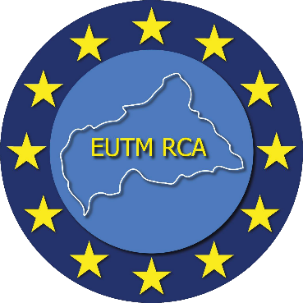
The European Union Training Mission in the Central African Republic (EUTM-RCA) is a European Union multinational training mission headquartered in Bangui, Central African Republic.

The European Centre of Excellence for Civilian Crisis Management e.V. (CoE) is based in Berlin. Its task is to enhance civilian crisis management within the framework of the EU Common Security and Defence Policy (CSDP). It is a service provider for its 22 members, the European External Action Service (EEAS) as well as civilian crisis management missions. Currently it has a staff of 20, among them Senior Advisors from Finland, Lithuania, the Netherlands and Sweden.
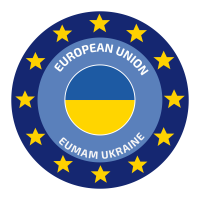
The European Union Military Assistance Mission in support of Ukraine is the European Union's (EU) first-ever military assistance mission for Ukraine set up on 17 October 2022. The decision to establish EUMAM was made by the Council of the European Union in response to Ukraine's request for military support during the ongoing Russian invasion of the country. The primary aim of the mission is to provide training to the Armed Forces of Ukraine in the territory of the EU member states.
